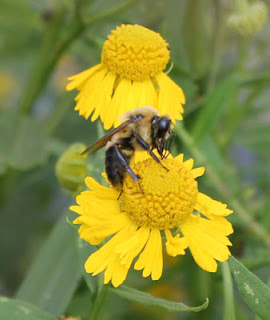My, my, the chicks are getting big! Terry found one of the
Whiting True Blues outside the fence one evening and asked me if I was sure it
wasn’t one of the hens. As luck would have it, I had remembered to count to six
before I shut the door on Coop 2 that night. Terry opened the gate to Coop 1,
and the errant pullet (I suspect it was Amelia, our wanderer) walked right in.
 |
| Amelia Noire, the adverturer |
Here’s a group shot of all but one of the Dominiques as they
came out to inspect some cantaloupe rinds. This was their first time, and they
didn’t quite know what to make of them.
 |
| Pullets inspect cantaloupe rinds |
The hens, on the other hand, thought the scraps were the
best thing ever, especially the seeds.
Bianca is no longer white. Her chest feathers are coming in
a dark brown. Frankly, it makes her look untidy, but it’s not fair to judge.
 |
| Bianca's brown chest feathers |
You may have heard (or not) that you can tell the color of
the eggs a hen will leg from her earlobes, at which point you probably thought,
“Chickens have earlobes?” When I was out taking pictures, I noticed that I
could actually see Carmella’s earlobes, which if you use your imagination are
kind of blue.
 |
| Carmella's earlobe |
The wild turkeys make the rounds every day. Terry watches
carefully that they don’t go near the garden. He has been known to hop up in
the middle of supper to run out after them, yelling and clapping his hands. It’s
quite a spectacle.
One evening, I saw a bird that did not match the usual
profile of the familiar robin.
 |
| A new visitor to the lawn |
I didn’t get a great picture, but this view shows the
characteristic yellow breast and black chevron of the Eastern meadowlark.
 |
| It's an Eastern meadowlark! |
Out in the butterfly garden, the sneezeweed (Helenium autumnale) is blooming
profusely. It is providing food for many insects. In particular, the soldier
beetles are having a huge party and mating frenzy.
 |
| Soldier beetles mating on sneezeweed |
Here is a flower that is hosting a well-camouflaged yellow
larva of some sort.
 |
| A yellow larva on a yellow flower |
I also saw a number of bees, like this small bumble bee.
 |
| A small bumble bee |
And this one, with its pollen sacs full.
 |
| A solitary bee with full pollen sacs on back legs |
Here’s another one. I don’t know if it is the same or
different from the previous bee. It doesn't seem quite as hairy and is smaller.
 |
| Another solitary bee with full pollen sacs--maybe a different species? |
Notable in its absence is the European honeybee. All the
bees I saw were solitary. I’m happy to be supporting the native bees, although
I do wonder why the honeybees don’t find the sneezeweed attractive. Maybe they
don’t like to compete with the soldier beetles.
No comments:
Post a Comment